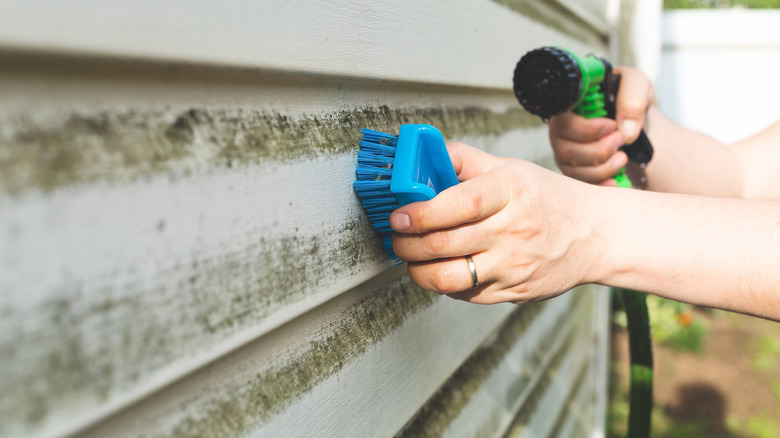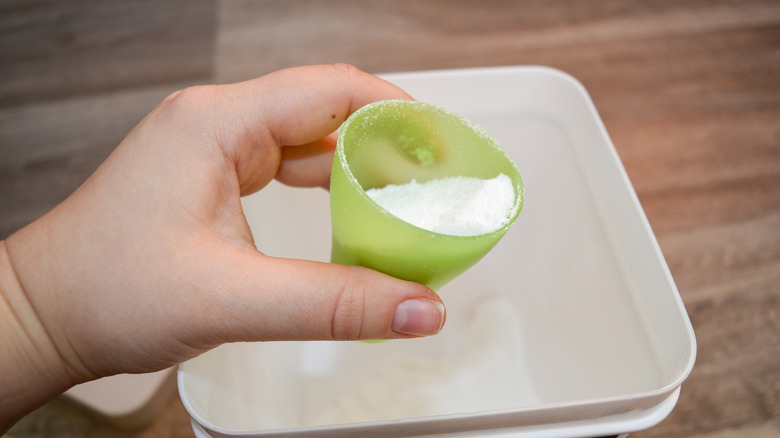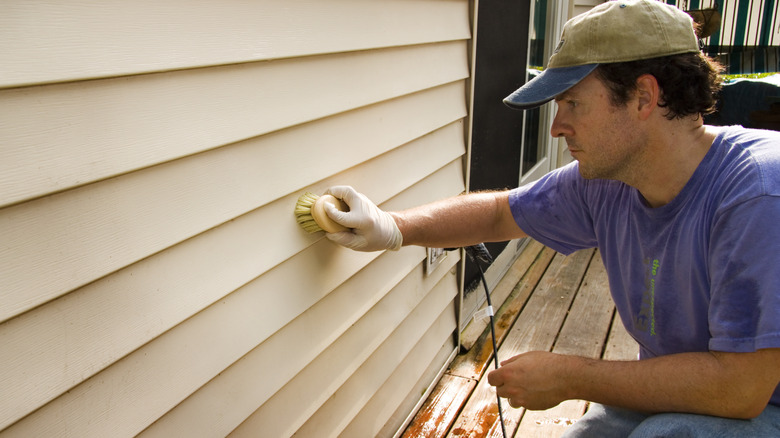Tackle Algae & Mildew On Vinyl Siding With A Laundry Room Staple
We may receive a commission on purchases made from links.
Vinyl siding can start to look a little rough after a while, especially if you live in a humid or shaded area. Whether you're getting ready to repaint the exterior, wanting to boost curb appeal, or just bothered by the green gunk creeping up the side of your house, giving your siding a proper clean makes a huge difference. Dirt, algae, and mildew love to cling to siding and thrive in shady or damp environments that don't get much sunlight. Luckily, you don't need any fancy tools or expensive cleaners to tackle it — you probably already have everything you need sitting in your laundry room. All you need to banish mildew and algae from your siding is a free afternoon and some powdered laundry detergent, bleach, powdered cleaner, a soft-bristled brush, and a garden hose.
While it might seem harmless at first, this buildup is more than just an eyesore. Aside from maintaining aesthetics, it's also crucial to remove algae, mold, and mildew from your siding to keep the exterior structurally sound. If left too long, fungal growth can weaken the siding, allow moisture in, and even spread to your interior walls. This quick, affordable DIY solution is a total game-changer for making your siding look fresh and new again — and protecting your home from potential damage. Here's how to mix up the solution and blast away gunk for good.
Powdered laundry detergent and bleach clean grime from siding
If you're looking for a gentle & affordable algae solution for your house siding, this cleaning concoction will cut through algae, mildew, and any other outdoor funk that's clinging to your siding. Start by mixing up your solution in a bucket or large container. Always check that your products are safe to combine before mixing! Dilute one quart of Clorox Original Laundry Bleach with one gallon of water. Stir in one-third cup of bleach-safe powdered laundry detergent, such as Boardwalk Powdered Laundry Detergent and two-thirds cup of a powdered household cleaner, like Comet Cleaner with Bleach.
Grab your soft-bristled brush and gently scrub your siding with the homemade cleaning solution. Gentle motions are key here — no need to go overboard and risk scratching your siding. The mildew should lift away before your eyes. Once you've given everything a good scrub, thoroughly rinse it with a garden hose. Make sure you're getting every nook and cranny so there's no leftover soap or gunk.
The reason this vinyl siding cleaning concoction works so well is due to its combination of ingredients. Laundry detergent contains surfactants, which help to break down dirt and grease. Bleach is a disinfectant that contains sodium hypochlorite that will help to break down mold, mildew, and algae, and powdered cleaner will add some abrasive grit. If your siding is especially grimy, let the solution sit for a few minutes before scrubbing and rinsing.
Precautions and preventive care for your vinyl siding
This mixture will help you banish mildew from vinyl siding with classic cleaning staples you already own, but one major downside is that these chemicals will be rinsed into your yard. This hack may not be a good idea near your garden beds, lawn, or natural waterways. To reduce the chemicals leached into your environment, wipe the soap solution from the siding with paper towels or rags before rinsing. For a chemical-free solution, you'll likely need to use a siding-friendly pressure washer. Just make sure you're wearing safety gear and using the correct pressure level.
Once your vinyl siding is clean, you'll want to make sure the algae and mold don't return, but how often do you need to clean your exterior siding? It's a good idea to at least give your siding a good cleaning at least once a year. If you live in a particularly humid or shaded area, you may want to think about cleaning your siding more than that. The best times to clean your siding are usually around the spring or fall when the weather is mild.
Regularly checking in with your siding will help prevent any mold or mildew from gaining a foothold and reduce the need for intense scrubbing each time. You can focus on preventive care by ensuring good drainage around your home, removing close shrubs and nearby shade sources, cleaning out your gutters to avoid water pooling, and keeping an eye out for warped siding or gaps that could lead to moisture infiltration and water damage.


